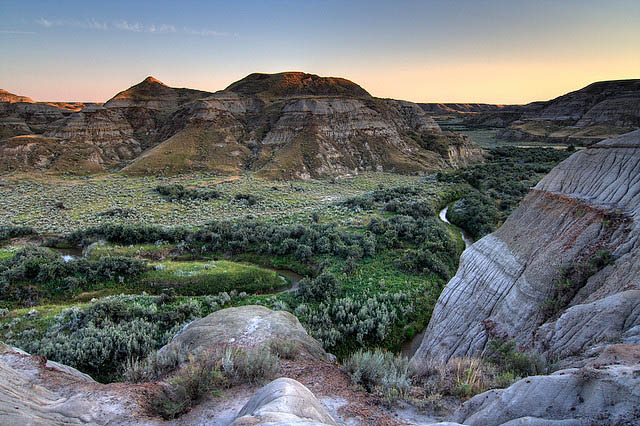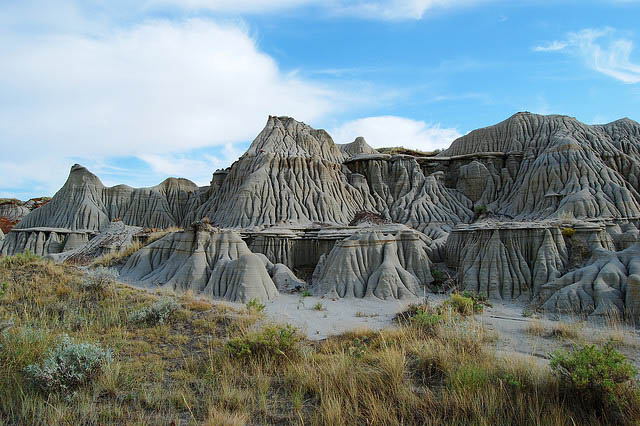In addition to its particularly beautiful scenery, Dinosaur Provincial Park – located at the heart of the province of Alberta's badlands – contains some of the most important fossil discoveries ever made from the 'Age of Reptiles', in particular about 35 species of dinosaur, dating back some 75 million years.
 |
| Dinosaur Bones at Dinosaur Provincial Park |
Dinosaur Provincial Park contains some of the most important fossil specimens discovered from the "Age of Dinosaurs" period of Earth's history. The property is unmatched in terms of the number and variety of high quality specimens, over 60 of which represent more than 45 genera and 14 families of dinosaurs, which date back 75-77 million years. The park contains exceptional riparian habitat features as well as "badlands" of outstanding aesthetic value.
Dinosaur Provincial Park is an outstanding example of major geological processes and fluvial erosion patterns in semi-arid steppes. These "badlands" stretch along 24 kilometers of high quality and virtually undisturbed riparian habitat, presenting a landscape of stark, but exceptional natural beauty.
The property is outstanding in the number and variety of high quality specimens representing every known group of Cretaceous dinosaurs. The diversity affords excellent opportunities for paleontology that is both comparative and chronological. Over 300 specimens from the Oldman Formation in the park including more than 150 complete skeletons now reside in more than 30 major museums.
Dinosaur Provincial Park - located at the heart of Alberta's badlands - contains some of the most important fossil discoveries ever made from the 'Age of Reptiles', in particular about 35 species of dinosaur, dating back some 75 million years.
Dinosaur Provincial Park is located in the Dry Mixedgrass Subregion of the Grassland Natural Region. This is the warmest and driest subregion in Alberta. Permanent streams are relatively rare, although the ones that do exist are deeply carved into the bedrock in some places. This as exposed Cretaceous shales and sandstones, creating extensive badlands, the largest in Canada.
Great rivers that flowed here 75 million years ago left sand and mud deposits that make up the valley walls, hills and hoodoos of modern-day Dinosaur Provincial Park. About 15,000 years ago this area was flat and covered by an ice sheet some 600 m thick. During this ice age, glacial melt water carved steep-sided channels; ice crystals, wind and flowing water continued to shape the badlands. Today, water from prairie creeks and run-off continues to sculpt the landscape and expose bedrock.
During the late Cretaceous period, 75 million years ago, the landscape was very different. The climate was subtropical, with lush forests covering a coastal plain. Rivers flowed east, across the plain into the Bearpaw warm inland sea. The low swampy country was home to a variety of animals, including dinosaurs. The conditions were also perfect for the preservation of their bones as fossils. Between 1979 and 1991, a total of 23,347 fossil specimens were collected, including 300 dinosaur skeletons.
Geological strata of the Judith River formation have yielded many of the dinosaur remains for which the park is renowned. Some 35 species of over 34 genera of 12 families of dinosaurs have been found in the park, including specimens from every known group of dinosaurs from the Cretaceous period. The families Hadrasauridae, Ornithomimidae, Tyrannosauridae, Nodosauridae, Pachycephalosauridae and Ceratopsidae are best represented. Other fossil remains include fish, turtles, marsupials and amphibians.
About 6% of the park is occupied by significant and, for the most part, undisturbed riparian habitat shaped by the meandering channel of the Red Deer River and characterized by point bars, wide terraces, fans and cut banks.
The river terraces support lush and diverse vegetation in various successional stages, ranging from pioneer willow stands to structurally complex plains, cottonwood forest, tall shrub thickets, ephemeral wetlands and dense sagebrush flats. Plains cottonwood riparian communities are among the most threatened habitats in semi-arid regions. The 'badlands' provide habitat for a number of ecologically specialized plant species and are characterized by open vegetation dominated by plants of the genus Artemisia and the family Chenopodiaceae. Remnant and recently created grasslands occur on buttes and large pediments.
The mild winter microclimate, coupled with an abundant food supply, provides critical winter range for native ungulates such as pronghorn, mule deer and white-tailed deer. The relative richness and abundance of breeding avifauna is noteworthy. Over 150 species of bird have been recorded. The area supports a number of species locally threatened or at their biogeographic limits, including golden eagle, prairie falcon, ferruginous hawk, loggerhead shrike, merlin, sparrow and grasshopper sparrow. Plains spade-foot toad also occurs.
Text source:- Wikipedia. Images are copyrighted by their owners. Found any copyright issue, contact the administrator immediately. Report it now!
You have read this article Canada /
Heritage /
Heritage Natural /
National Parks /
North America /
North America Heritage
with the title Dinosaur Provincial Park. You can bookmark this page URL http://tiffanyeatworld.blogspot.com/2011/12/dinosaur-provincial-park.html. Thanks!





























